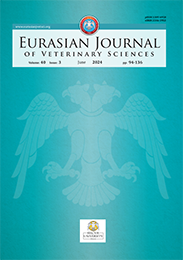| 2014, Volume 30, Number 3, Page(s) 162-165 |
| [ Summary (Turkish) ] [ PDF ] [ Similar Articles ] |
| Gastro-intestinal helminths detected by fecal examination in stray dogs in the Konya province |
| Nermin Işık1, Özlem Derinbay Ekici1, Serkan İrfan Köse2 |
| 1Selçuk Üniversitesi, Veteriner Fakültesi, Parazitoloji Anabilim Dalı, Konya, Türkiye 2İç Hastalıkları Anabilim Dalı, Konya, Türkiye |
| Keywords: Köpek, helmint, Konya |
| Downloaded:1653 - Viewed: 3663 |
|
Aim: This study was carried out to determine the prevalance
of gastro-intestinal helminths in stray dogs in Konya Municipality
Animal Shelter, between January-March 2014.
Materials and Methods: In this study, a total of 316 stool samples with different ages and sex were used as a material. Stool samples were examined by native, Fulleborn flotation and Benedek sedimentation methods in University of Selcuk, Faculty of Veterinary Medicine, Department of Parasitology. Results: The overall prevalence of infection with intestinal parasites was 19.9%. Six types of helminth eggs (1 trematoda, 1 cestod and 4 nematodes) were identified in infected feces samples. The parasites species most frequently observed in stray dogs were Toxocara canis (13.9%) and Toxascaris leonina (6.9%). No statistically significant differences in prevalence occurred between other parasite species [Uncinaria stenocephala (0.6%), Ancylostoma caninum (0.3%), Dipylidium caninum (0.3%) and Taenia spp. (0.3%), (P>0.05)]. Infections with a single parasite species (17.4%) were common than were infections with multiple parasite species (2.5%). There was no significant difference in overall prevalence between male (38.9%) and female (31.7%) dogs (P>0.05). The study also indicated significant difference in dogs younger than 1 year of age (P<0.05). Conclusions: Zoonotic intestinal parasites in stray dogs such as Toxascaris leonina and Toxocara canis should be considered more seriously and it is necessary to take precautions against these infections. |
| [ Summary (Turkish) ] [ PDF ] [ Similar Articles ] |





